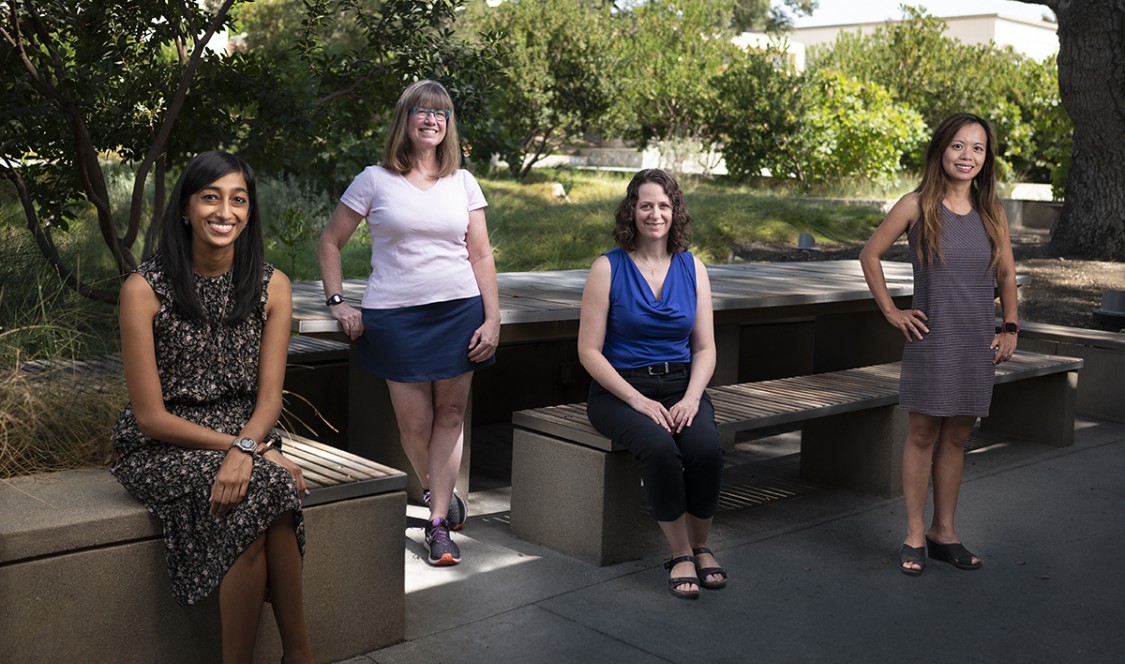From investigating the resiliency of young adults to turning back the clock on memory for older populations, four professors in CMC’s Psychological Sciences department are looking at how we mentally manage our world. And their outstanding work has been rewarded with five large, highly competitive, external grants—virtually unprecedented for professors at small liberal arts colleges, especially in a single year—to fund research and further teaching at CMC.
“This is a true testament to the overall excellence of our department,” said Daniel Krauss, who chairs Psychological Sciences. “I’m so proud of our professors and the excellent research they produce. To receive this level of grant funding when they must compete against scholars from larger research universities—and accomplish this all while providing exceptional educational opportunities for our undergraduates—is extremely unusual.”
In a series of Q&As, Profs. Stacey N. Doan, Sharda Umanath, Alison Harris, and Cathy Reed share details about their research projects, and how these grants will impact their work.
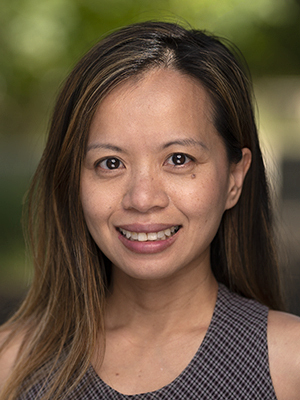
Stacey N. Doan: Emotions, stress, and health
Doan, associate professor of psychological sciences, received a Ho Family Foundation Special Programs grant to investigate resilience training for young adults and a National Institute of Child Health and Development grant to explore children's academic competence in contexts of risk. She was also awarded a RAPID grant from the National Science Foundation to study the effects of the coronavirus pandemic on families with young children.
Doan is the director of the Berger Institute.
What can you share about your current research projects? Are you seeing any initial results?
For our NSF grant, we have now collected data on over 150 families in the Inland Empire and interviewed just as many. We have several exciting findings that we are preparing to write up. To illustrate, we have found that mothers who were trained in a relational savoring exercise—an intervention that encourages them to experience and reflect on times when they were a source of strength for their children—were more likely to engage in health behaviors, but also had children with lower levels of behavioral problems. With regards to the Ho grant, we are in the exciting stage of developing an evidence-based intervention to reduce stress and improve well-being in college students.
How are the grants you received impacting your work?
The NSF grant allows us to advance our current work in very unique circumstances. The Ho Foundation grant is a pivotal resource that allows us to apply our decades of research on stress and resilience. The planning grant from the foundation allows myself and my team to develop a resilience intervention focused on emerging adults.
What makes earning these grants significant?
These grants are very competitive, and acknowledge that our ideas are exciting and engaging, that we have the experience to do the study, and the questions are important enough to be fundable.
How is being at CMC conducive to achieving these accomplishments?
The psychological science department is very supportive as a whole. We have an excellent mentoring system, and our chair, Daniel Krauss, is a fierce advocate for junior faculty. Importantly, CMC values research—and it is not just lip service. There are concrete resources for faculty to launch research programs, test innovative ideas, as well as nurture our students to the process. For example, seed money is so important for initiating research programs and the college makes a tremendous effort to invest in new faculty with start-up funds. In addition, at CMC, the Institutional Philanthropy staff—including Abby Flores and Beth Jager—are amazing at connecting faculty with potential funding sources. There is so much behind-the-scenes work that needs to be done even before a grant is submitted—that has nothing to do with the science that Abby and Beth work so tirelessly on. I would be amiss not to mention them.
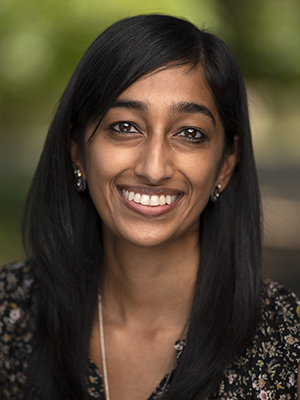
Sharda Umanath: Aging, memory, and reclaiming marginal knowledge
Umanath, an assistant professor of psychology and the director of CMC’s Memory and Aging Lab (UMA Lab), was recently awarded a CAREER award from the National Science Foundation. She studies knowledge and its influence on memory.
What is your current research project?
It’s a five-year project[1] that aims to empirically define a zone of proximal retrieval, where inaccessible knowledge resides and can be reclaimed with the aid of prompts and other learning strategies.
What drew you to this research?
An older adult participant in one of my dissertation studies at Duke University said to me: “I wish I could say ‘I don't remember’ instead of ‘I don’t know’ on this test. Because I know I know this answer. I just can’t get at it.’”
I have been mulling over that remark for a long time since. And recently, I have gotten the chance to explore the important distinction that this older adult was trying to make.
How will this grant impact your work?
My research team—including CMC undergraduates, as well as Dr. Jen Coane at Colby College and her lab group—will use general knowledge questions to pin down the marginal knowledge (MK) base with eventually about 200 volunteers, defining the buckets of knowledge retrieval failure in healthy aging along the way. Then we’ll apply the abundant literature on effective study strategies for learning new information to see what works best to retrieve and retain MK in adults, documenting how that differs in younger and older adults.
What makes this grant so significant?
First, it is providing me an opportunity to set up my research program going forward in a concrete way. And, what makes this grant really special is that half of it is related to teaching—you need a clear idea of how to translate the research into educational initiatives.
Student research assistants will be part of every step of the research, from recruiting older adult participants all the way to disseminating study results at conferences and through seminars that we will organize at local retirement communities.
Another educational component of the grant will fund a new pre-orientation program for first-generation CMC students in partnership with the Dean of Students Office and the student group 1Gen.
The grant will also support a special service-learning course on aging and memory, run in partnership with the Pilgrim Place senior community’s Napier Initiative. The intergenerational class will bring together undergraduates and seniors interested in the topic.
How is being at CMC conducive to achieving these accomplishments?
The whole community of older adults has this sense of engagement with research at the Claremont Colleges. I’m probably at the best liberal arts college to be doing this work because of the decades-long tradition of aging and memory research (led mainly by Dr. Deborah Burke at Pomona and Dr. Leah Light at Pitzer).
To what do you attribute the success of you and your CMC colleagues in being awarded these grants?
Within the psychological science department, there is an environment around having active research labs and most importantly, involving undergraduates in our work. We find ways to keep asking and answering the questions we are excited about, including seeking grant funding. We want to share that enthusiasm with our students and help them understand what research is all about.
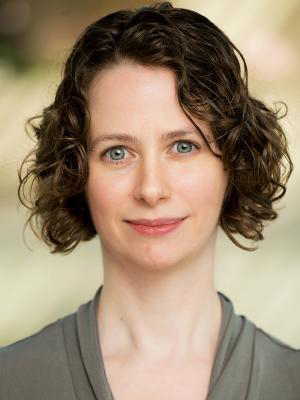
Alison Harris: Perceiving emotional body language
Harris, Cook-Ostby associate professor of psychological sciences and neuroscience and George R. Roberts fellow, received a National Science Foundation grant for collaborative research with CMC colleague Cathy Reed. A cognitive neuroscientist, she is interested in how activity in the brain gives rise to complex cognitive behaviors, and is the principal investigator of the Decision Neuroscience Laboratory at CMC.
What is the focus of your current research project?
The focus is how we perceive other people’s body movements, and which brain systems contribute to this ability. From jumping jacks to jumping for joy, other people’s body movements are a rich source of cues to what they are thinking and feeling.
My project is designed to carefully compare action execution and observation. Additionally, we are looking at the role of emotional content in the simulation process: does watching someone jump for joy produce a stronger effect than observing jumping jacks, or is it the other way around? This question could be particularly relevant for determining how mu rhythms (a type of brain wave recorded with electroencephalography) are affected in autism spectrum disorder (ASD), a neurodevelopmental disorder characterized by difficulties with social communication, which is a third aim of the project.
How will this grant impact your work?
This grant has helped me to carve out time to focus on scientific research, for example by allowing me to take a two-semester research sabbatical over the past year. With the funds from the grant, I have also been able to invest in additional resources for my laboratory. Finally, with the time and funding provided by the grant, I was able to hire and train a new team of undergraduate research assistants, whose hard work is so critical for collecting data and moving the research forward—not to mention the energy and enthusiasm they bring to the lab!
What makes this grant significant for you?
I’d been warned before I started applying for competitive grants not to expect to receive an award on the first submission, so it was gratifying to be selected for funding on the first round. Otherwise, this research is special to me personally because it draws directly on a senior thesis project that I supervised by Audrey Siqi Liu ’18. She is now a graduate student in the Cognitive Neuroscience program at Duke University.
What drew you to this research?
One of my longstanding interests is high-level vision, how the brain interprets visual information to recognize complex stimuli like faces and bodies. I have also recently begun to explore how information about movement is integrated with value signals to influence decision-making.
To what do you attribute the success of you and your CMC colleagues in being awarded these grants?
Our Department of Psychological Science is a powerhouse in terms of research at liberal arts institutions. While obviously there are many factors that go into grant awards, many CMC Psychology faculty have strong research programs, high research productivity, and high student involvement in research (something that the NSF particularly values). At the same time, we have a collegial atmosphere with many opportunities to interact and pursue collaborative research: for example, my recent grant proposal grew out of discussions with Cathy Reed, who is also a co-investigator on the grant. Undoubtedly, all of those factors make for stronger research and more competitive grant proposals.
How is being at CMC conducive to achieving these accomplishments?
I feel fortunate to have the support of fantastic colleagues at CMC and in the Department of Psychological Science, in particular. I’m also grateful to the administration for helping me to put together an advanced cognitive neuroscience lab, and to the many students who have volunteered their time and energy in the lab.
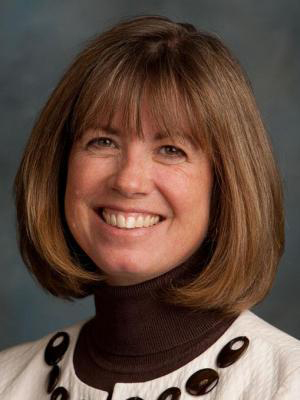
Cathy Reed: STEM research opportunities for undergraduates
Reed is the McElwee Family Professor of Psychology and a George R. Roberts Fellow. She received a National Science Foundation “Preparing Undergraduates for Research in STEM Using Electrophysiology (PURSUE)” grant and is co-PI on the NSF grant with Alison Harris (For details about the collaborative research with Harris, please see Alison Harris Q&A). Reed’s research examines influences of the body on attention, perception, and emotional processing.
What are the goals of your research projects?
The goal of the PURSUE project —Preparing Undergraduates for Research in STEM Using Electrophysiology— is to develop course materials and tools to help faculty train undergraduates in cognitive electrophysiology and engage them in authentic, collaborative research. Cognitive Electrophysiology is a direct measure of brain activity measured through the scalp. Few colleges offer such training at an undergraduate level, despite its relevance to STEM-related career opportunities. To meet this need, we have developed and disseminated information resources (e.g., PowerPoints, animations, simulations, and data sets) to assist faculty in engaging undergraduates in research. Based on information from faculty requests, our materials will be used to train approximately 2,678 undergraduate students and 845 graduate students this year.
Further, we have built a cognitive electrophysiology teaching/research community to supports faculty across the country and world. (Access to these materials are found at pursueerp.com.)
For our five-year, $2-million NSF Level II grant, we will complete a semester-long cognitive electrophysiology course that can be taught face-to-face and online. We will hold workshops to guide faculty through course adoption and implementation. By tailoring workshops for multiple audiences (those who wish to modify existing courses, implement a new course, or add a component to an existing course), this grant can impact curricula across many institutions. The workshops provide a forum for community development, fostering cross-lab collaboration, and mentorship. The online accessibility of our materials allow faculty worldwide to increase opportunities for serving underrepresented populations.
How will this grant impact your work?
The Level II PURSUE grant will have an impact on my teaching and research programs. I plan to offer a new, hands-on semester-long course on Cognitive Electrophysiology using the materials developed in the grant. Also, the grant allows new research opportunities for undergraduates to gain skills necessary for conducting original EEG/ERP research in my laboratory. The undergraduates’ ideas inspire me to explore new research questions.
What is significant about these grants?
The PURSUE grants allow us to develop not only a freely downloadable, high-quality set of instructional materials that can facilitate the careers of faculty and students alike, but also develop an international teaching/research community to support the professional development of faculty at all levels.
What drew you to this research?
The PURSUE project began when we attended an event-related potentials (ERP) boot camp and realized that all the training was geared to people who had extensive backgrounds in cognition, neuroscience, physics, computer science, and statistics. We were told that the material was too complicated for most undergraduates. Because we ran EEG labs at liberal arts colleges, we knew that undergraduates could learn EEG/ERP with the appropriate training. As a result, we saw an opportunity to make a difference, not only for ourselves, but also for others. These grants allowed us to develop a hands-on, interactive EEG/ERP course that employs cutting-edge pedagogical approaches with a focus on active student learning.
To what do you attribute the success of you and your CMC colleagues in being awarded these grants?
One reason for our success is the CMC Psychological Science department’s ability to attract top-level faculty. Another reason is our access to top-level undergraduates. In addition to the excellent undergraduates, CMC has provided lab space and some equipment needed to conduct the research.
— Anne Bergman
[1] With the NSF’s agreement, all of the work has been postponed a year due to the pandemic and will start in June 2021.

